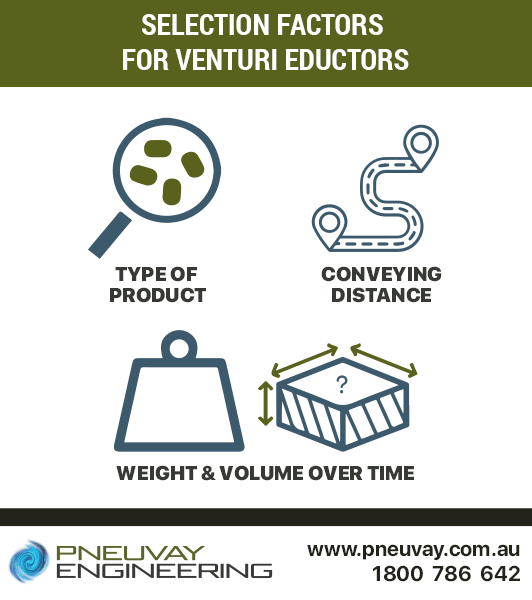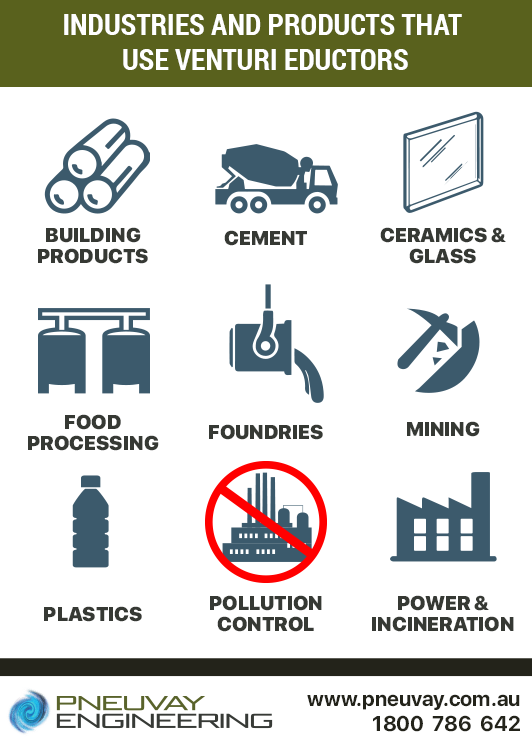See our latest projects and be updated with recent news and features
happening in the world of pneumatic conveying, materials handling
and industrial vacuum systems.
See our latest projects and be updated with recent news and features
happening in the world of pneumatic conveying, materials handling
and industrial vacuum systems.

Friday, February 28, 2020
With numerous venturi eductors on the market, it is important to research what products are best suited to the situation to which they are to be applied. There are three main factors determining the parameters of a venturi-based pneumatic conveying system:

Factors to consider when selecting venturi eductors
One of the three main factors used in determining the parameters of venturi eductor-based systems is the type of product. Venturi eductors are best for conveying products that are abrasive, fine, fragile or irregularly-shaped. However, they can be used to transport most types of bulk powder, pellets and granular products. Below is a list of some of the products typically suitable for venturi eductor-based systems:
This is by no means an inclusive list but gives an idea of what materials can be used.
The three main factors (see above) are used to determine the design and structure of an eductor, for example, the type of housing used. This housing needs to be suitably robust so it complies with industry standards such as ANSI (American National Standards Institute). The flow paths within the eductors need to be designed for superior efficiency, and the eductor profiles must be machined to a suitably smooth surface for optimum performance.
Two of the three main factors will determine if a venturi eductor is possible. There are limits to the volume and weight of product that can be conveyed over time, and how far it can be conveyed. The maximum limit for venturi eductor-based pneumatic conveying systems is transport capacity up to 15 tonnes per hour over distances up to 100 meters. It is possible to design systems beyond these limits; however, an expert pneumatic conveying systems integrator is required.
There are many other minor factors that help determine the requirements of a venturi-based pneumatic conveying system. Some require expert investigation and are best put in the hands of an expert system integrator.
It is ideal to engage an expert system integrator, who can provide the support needed around the venturi-based pneumatic conveying system, in preference to a standalone supplier. An expert system integrator would be able to assist in the design, supply, installation and maintenance of all system components.
They would be able to supply and maintain any required blowers (types and output levels) and include the accessories, filters, hoses and fittings as part of their best-fit solution. They would also guarantee their work. Their experience should lead to the development of a best-fit solution with a well-executed installation.
Engaging experienced design experts is ideal when implementing the installation of a pneumatic conveying system within a new plant. They can help determine if the system can work with venturi eductors from the start. This will avoid having to retrofit the plant later if it was wrongly designed at first with rotary valves or electric pumps.
It is recommended that experienced design experts be engaged when considering retrofit and replacement of an existing rotary valve-based system with a venturi eductor-based one. Retrofitting existing pneumatic conveying systems with eductors can have some technical and commercial challenges. A detailed analysis of the existing blower, pipe geometry, dust collection and conveyed rate material is required to check feasibility.
Venturi eductors (jet pumps) can be used in any industry requiring pneumatic conveying. There are, however, several major industries that are dominated by the use of venturi eductors over other types of pneumatic conveying systems.
The building products industry uses venturi eductor based pneumatic conveying systems to convey:
In the cement industry, Venturi eductors are used in pneumatic conveying systems to transport products such as:
Venturi eductor based pneumatic conveying systems are used in the ceramics and glass industries to transport products such as:
Glass frit is a porous glass through which gases and liquids may pass. It is produced by sintering particles of glass into a solid but porous form. Sintering (frittage) is when solid material is formed when it is compacted by heat or pressure without melting (not passing the liquefaction point of the material).
The food processing industry uses venturi eductor based pneumatic conveying systems to drive milk and non-dairy powder spray dryers. They are also used to transport products in processes that include:
Minor ingredients include products like flavourings, salt, sugar, spices and vitamins.
The foundries industry makes metal castings and uses venturi eductor based pneumatic conveying systems to transport:
Inoculants are used to improve the chemistry of molten iron to ensure that carbon will precipitate as graphite, rather than iron carbide. Iron melted in cupolas respond better to inoculation than irons melted in coreless induction furnaces.
Venturi eductors are used in pneumatic conveying systems for the mining industry, to transport products such as mica, perlite (mined volcanic glass), quartz and talc from dust collectors. Also transporting in more extreme conditions such as:
The plastics industry uses venturi eductor-based pneumatic conveying systems to:
Venturi eductors with ceramic-lining are wear-resistant and allow for clean-in-place (CIP). CIP is a method of cleaning the interior surfaces of the eductor without disassembly.
Venturi eductor-based pneumatic conveying systems are used in the pollution control industry for sorbent injection in fluidised bed boilers for sulphur oxide reduction. They also are used to transport into stacks and ducts such products as:
Venturi eductors are used in pneumatic conveying systems for the power generation and incineration industry, for transporting products in processes such as:

What industries and products are used by venturi eductors?
With more than 30 years experience, Pneuvay has been helping Australian industry select the best-fit venturi eductors for their pneumatic conveying systems. We have expertise in a wide range of companies designing, installing and maintaining venturi educator systems that:
If you are in the process of selecting venturi eductors, feel free to call us on 1300721458 or send us a message via our Pneuvay website contact page or Pneuvay Facebook page.
Get social with us and see the latest news items from:
Vortex Global is proud to appoint Pneuvay Engineering as its sole agent for New Zealand.
Read on to find out how this set a new standard for bulk material handling solution for Australia and New Zealand.
Pipe and Tube Compression Couplings
Industrial Dust Collectors Systems
Dust Collectors Filters, Cartridges and Bags
Pneuvay Engineering Pty Ltd - Copyright 2020
ABN 49 006 027 541
